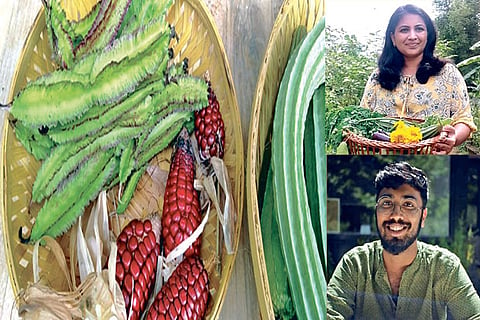

Chennai
“I got an overwhelming response to the corn picture. Many messaged me asking for details of the corn. Everyone appreciated this rare produce but told me that they don’t have access to it. Then I realised how this corn variety which was once common has become so rare that we hardly see them anymore. Why is it so? It all started after hybrid varieties that were cultivated for mass consumption entered the markets. Products that are commercially viable and get good sales are overproduced and slowly others get pushed back into oblivion. Sadly, consumers don’t have other choices – they have to buy what comes to the market. They cannot voice their opinion or ask for other varieties. In the end, what you buy is made available to you. This vicious cycle continues till hybrids and other easy to mass-produce ones had completely taken over the food industry. They are promoted as good for health, easy to cook, etc, and we conveniently forget the nutritious rest,” fumes Kalpana. This is not something that happened overnight, but the shift has been happening for decades. “Some of the fruits, vegetables and grain varieties that were commonly grown and cultivated in our state are not in the picture anymore. Earlier, the farming system was multi-cropping and farmers were able to grow more varieties. Commercialisation, marketing and vested interests of the food industry have altered the farming system. What a person should eat is decided by food industry giants. Death of food diversity is real and it creates great immunological damage to our body system.”
Kalpana says that the only way to save native fruits, grains and vegetables is by creating awareness for both farmers and consumers. “We need to fight for food diversity and bring back our native varieties. We have to become conscious consumers and make enough noise that the food industry takes notice. We don’t have to be helpless bystanders. We can take control of what we eat/what we want to eat. What we want to consume can’t be decided by someone else. As a consumer, we have the right to question but we don’t make use of it. If you want every household in the country to eat rare, nutritious vegetables, then you have to question the system. I have visited a few farmers’ markets that are organised across the country – in this, farmers from various parts of India come together and showcase their products. At these places, farmers share/sell seed varieties. If people get access to it, they can cultivate it. The more the rare varieties grow the more it will be in circulation and the chances of it becoming extinct will reduce,” she suggests.
Another best way possible to save native varieties is by growing it ourselves. “An alternative way to counter this is by growing rare vegetables in our garden. You will get to consume it even if it is not available in the market. Growing food is a superpower and I keep saying that often because it is. People don’t even know when a fruit or a vegetable gets extinct. This attitude should change. We have already lost 95 per cent of our food diversity,” she adds.
Food designer Akash Muralidharan did a 100-day project where he cooked 100 recipes using many of the vegetables that have started disappearing from our kitchens. “Daily, I posted history about each
vegetable and shared a recipe with that particular vegetable from Meenakshi Ammal’s book titled Samaithu Paar. It was like investigating ‘missing’ vegetables. I cooked with almost 70-80 varieties of vegetables that are not available in the city markets I sourced them from elsewhere. There can be many reasons why farmers are not cultivating certain native vegetables and why consumers are not bothered about it. Today’s generation follow food bloggers or watch online videos to do the cooking. They hardly ask families for traditional recipes. This way, techniques and awareness on how to cook with certain veggies are getting lost,” says Akash.
The youngster opines that unlike before, today, people spend less time in the kitchen. “Many prefer vegetables that are easy to chop, clean and cook. Certain vegetables take time to clean and cook. But nobody is willing to spend an extra hour in the kitchen. So, they go with easy to cook veggies, grains. Another reason I have noticed is that we don’t do meal planning anymore. Many of us don’t remember what we cooked two or three days ago and we tend to repeat the same veggies without being aware of it. The dishes might vary, but the veggies used in them will be the same.” Mono cropping and unsustainable agricultural practices have largely affected food diversity. “There should a conscious change in the mindset of farmers and consumers. That’s the only way forward.”
Visit news.dtnext.in to explore our interactive epaper!
Download the DT Next app for more exciting features!
Click here for iOS
Click here for Android